

IV.6.2 Arene Substitution Involving Temporary Incorporation and Removal of Carbon Tethers via Carbopalladation and Decarbopalladation
MARTA CATELLANI
A. INTRODUCTION
This section deals with a unique new methodology for the synthesis of selectively substituted aromatic compounds. Two examples of twofold (Eq. 1) or single ortho alkylation (Eq. 2) of aryl iodides[1],[2] occurring with temporary incorporation of norbornene accompanied by an alkenylation reaction are presented in Scheme 1.
In the absence of alkylating and alkenylating agents, complex arylation reactions of the aromatic rings occur (Scheme 2) with permanent incorporation of norbornene into a hexahydromethanotriphenylene structure without (Eq. 1)[3] or with an additional aryl substituent (Eq. 2).[4],[5] All these reactions are carried out under mild conditions.
B. MECHANISTIC BASIS FOR A METHODOLOGY DESIGN
The novel synthetic methodology described here is essentially based on the exploitation of the properties of palladacycles formed from arylpalladium species and alkenes. Insertion of the latter into the arylpalladium bond corresponds to an equilibrium leading to a complex that does not readily undergo -hydride elimination.[6]
A variety of reactions can be achieved taking advantage of this circumstance. They will be treated in Sect. IV.2.4, the present section being restricted to the title methodology.
The occurrence of insertion equilibria usually is obscured by fast -dehydropallada- tion followed by base-promoted reductive elimination leading to overall alkene arylation and formation of palladium(0) (Scheme 3) (see Heck reaction, discussed in Sect. IV.2).
If however, a bicyclic alkene is used, syn- -hydride elimination from the carbopalladation product is disfavored,[6] and the reaction proceeds further through a sequence of steps until a favorable reductive elimination becomes feasible. A precedent of an insertion equilibrium not leading to -hydride elimination can be found in nickel chemistry,[7] where it was shown that norbornene inserted into a methallylnickel bond in the presence of acetate anion and deinserted in the presence of hydrogen halides (Scheme 4).
Handbook of Organopalladium Chemistry for Organic Synthesis, Edited by Ei-ichi Negishi ISBN 0-471-31506-0 © 2002 John Wiley & Sons, Inc.
1479
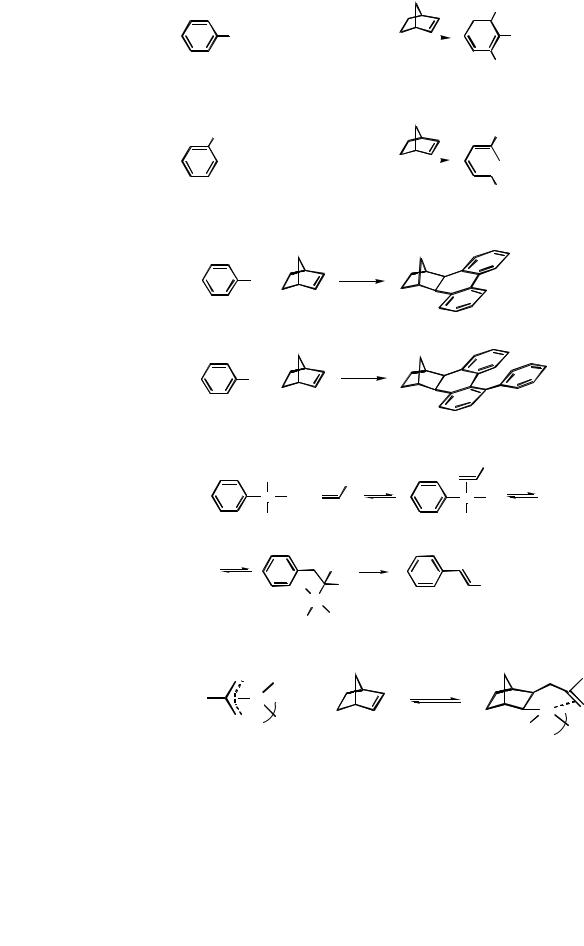
1480 IV Pd-CATALYZED REACTIONS INVOLVING CARBOPALLADATION
I + 2 RI + CH2=CHY |
Pd0, |
|
|
|
|
|
R |
|
||
|
|
|
|
|
|
|||||
|
|
|
|
|
|
CH=CHY |
(1) |
|||
|
|
|||||||||
|
|
|
|
|||||||
|
|
|
|
|
||||||
|
|
|
|
|
|
|
|
|||
− HI |
|
|
|
|
||||||
|
|
|
|
|
|
|
||||
R = alkyl; Y = alkyl, aryl, CO2Me, etc.
R1 |
+ R2I + |
CH =CHY |
Pd0, |
|
||
|
||||||
|
|
I |
|
|||
|
|
|
|
|||
|
|
|
|
2 |
− HI |
|
|
|
|
|
|
||
R1, R2 = alkyl; Y = aryl, CO2Me, etc.
Scheme 1
2 |
I |
+ |
Pd0 |
|
−HI |
||||
|
|
|
3 |
I |
+ |
Pd0 |
|
−HI |
||||
|
|
|
R
R1

 CH=CHY (2)
CH=CHY (2)
R2
(1)
(2)
Scheme 2
|
|
|
|
R |
L |
|
R |
− L |
L |
|
|
|||
Pd |
X + |
|
||
|
|
Pd X |
||
L |
|
|
|
L |
|
L |
R |
|
+ Pd0L2 + HX |
|
H |
|
R |
|
|
|
Pd |
|
|
|
X |
L |
|
|
|
|
|
|
|
|
|
|
Scheme 3 |
|
Cl |
|
|
KOAc |
|
Ni |
+ |
|
|
|
2 |
HCl |
Ni |
||
|
|
|
||
2 |
|
|
|
AcO |
|
|
|
|
2 |
Scheme 4
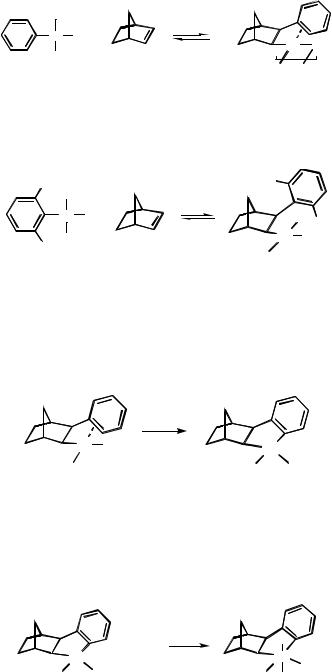
IV.6.2 ARENE SUBSTITUTION INVOLVING TEMPORARY INCORPORATION |
1481 |
Analogously, it was observed that norbornene could be inserted into an arylpalladium bond and the resulting product was stabilized through the formation of a dimer[8] or by appropriate ligands (Scheme 5).[9]–[11]
L |
− 2L |
|
Pd X + |
|
|
1/2 |
X |
|
|
Pd |
L |
2 |
|
Scheme 5
When substituents were present in both ortho positions of the aromatic ring the norbornene insertion equilibrium was pushed to the left[12] up to the point that no carbopalladation occurred with two bulky substituents on the arylpalladium halide (Scheme 6).
R |
|
|
R |
L |
|
|
|
Pd |
X |
+ |
L R |
|
|
||
L |
|
|
Pd X |
R |
|
|
L |
|
|
|
Scheme 6
Advantage of this equilibrium can be taken at an appropriate reaction stage (see below).Without substituents in the ortho positions, however, the reaction proceeds further to give a palladacycle (Scheme 7).[13],[14]
The palladacycle thus formed is the key intermediate for a successful selective aromatic alkylation or arylation.
|
L |
|
Pd X |
−HX |
Pd |
|
|
|
L |
L |
L |
|
Scheme 7 |
|
B.i. Alkylation
It was found that palladacycles formed from norbornene and aryl halides are susceptible to oxidative addition of alkyl halides RX with formation of palladium(IV) complexes (Scheme 8).[13],[15] Palladium(IV) complexes are discussed in Sect. II.4.
|
+ |
RX |
L |
|
|
Pd |
|||
|
Pd |
|
||
L |
L |
L |
X |
|
R |
||||
|
|
|
Scheme 8
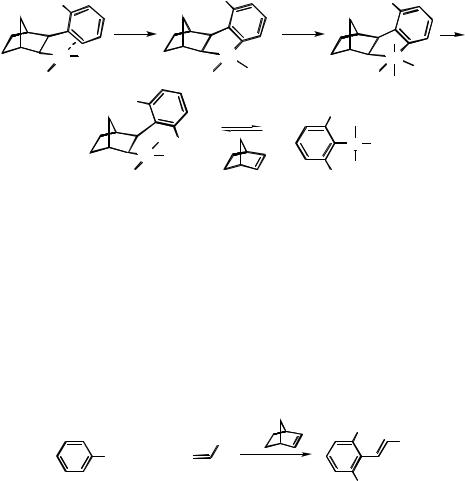
1482 |
IV Pd-CATALYZED REACTIONS INVOLVING CARBOPALLADATION |
The latter readily undergo reductive elimination leading to ortho-substituted palladium(II) complexes,[16] which cyclize again. Oxidative addition of a second molecule of RX and reductive elimination affords the , -disubstituted palladium(II) complex from which norbornene is deinserted owing to the unfavorable equilibrium (Scheme 9).
R |
|
R |
|
R |
|
L |
|
|
RX |
|
|
−HX |
|
|
|
L |
|
|
Pd |
|
|
||
Pd X |
|
|
Pd |
||
L |
L |
L |
L |
X |
|
R |
|||||
|
|
|
|
||
R |
|
|
R |
|
|
|
|
|
|
||
|
|
|
L |
|
|
Pd |
L R |
|
Pd X |
|
|
X |
− |
L |
|
||
L |
|
|
|||
|
|
|
|||
|
|
R |
|
Scheme 9
A perfectly selective functionalization at the two ortho positions of the aromatic ring of the aryl halide is thus achieved. It remains to be seen how a catalytic process can be worked out on the basis of these organometallic results. The palladium(0) species necessary to start a new catalytic cycle can be regenerated from the dialkylated arylpalladium species by letting it undergo reactions eventually leading to liberation of palladium(0) from the organic part. To this end a variety of reagents can be used. For example, alkenes readily react with these intermediates according to a Heck-type coupling so that the overall process becomes catalytic in palladium. Thus, when an aryl iodide, an alkyl iodide, norbornene, and a terminal alkene all in one-pot are treated in dimethylformamide (DMF) with a palladium catalyst in the presence of K2CO3 as a base at room temperature, , - dialkylated alkenylarenes are obtained (Scheme 10 and Table 1).[1]
|
|
|
R |
I + |
2 RI + |
Y Pd0, |
Y |
−HI |
|
||
|
|
|
|
|
|
15−93% |
R |
R = alkyl; Y = alkyl, aryl, CO2Me, etc.
Scheme 10
There is a considerable difficulty, however, in achieving the desired reaction sequence selectively because each component can react with any of the other ones. Thus, the initially formed arylpalladium complex may react with the terminal alkene according to a Heck-type coupling. Also, the palladacycle may react with the aryl iodide in preference to the alkyl halide and the palladium(0) formed may react with the alkyl halide rather than with the aromatic one. Furthermore, there are several termination steps that might be favored in the presence of the four organic reagents present in the reaction mixture. Fortunately, the competition among the different reagents can be controlled according to the

Yand
, 2 R, 1 (R
3 CO 2
TABLE 1. Reaction of Aryl Iodides with Alkyl Iodides and Terminal Alkenes in the Presence of Norbornene, PNP Dimer, and K
a 10)Scheme
inas
c Selectivity (%)
b Yield (%)
Product
Y
2 R
1 R
93
89
Me 2 "CHCO
CH 3 H 6 C 2 Pr)-n
(-2,6
Me 2 CO
n-Pr
H
30
15
Me 2 "CHCO
CH 3 H 6 C 2 Pr)-i (-2,6
Me 2 CO
i-Pr
H
93
93
Me 2 "CHCO
CH 3 H 6 C 2 Bu)-n
(-2,6
Me 2 CO
n-Bu
H
95
82
Me 2 "CHCO
CH 3 H 6 C 2 Oct)-n
(-2,6
Me 2 CO
n-Oct
H
96
82
Me 2 "CHCO
CH 3 H 6 C 2 Dod)-n
(-2,6
Me 2 CO
n-Dod
H
92
31
Me 2 "CHCO
CH 3 H 6 C 2 ) 4 H 2 C 9 F 4 (C-2,6
Me 2 CO
4 H 2 C 9 F 4 C
H
95
31
Me 2 "CHCO
CH 3 H 6 C 2 ) 4 H 2 (PhC-2,6
Me 2 CO
4 H 2 PhC
H
93
41
Me 2 "CHCO
CH 2 H 6 MeC-4
- 2 Bu)-n
(-2,6
Me 2 CO
n-Bu
4-Me
89
73
Me 2 "CHCO
CH 2 H 6 MeC 2 CO-4
- 2 Bu)-n
(-2,6
Me 2 CO
n-Bu
Me 2 CO-4
91
46
Me 2 "CHCO
CH 2 H 6 MeC-3
- 2 Bu)-n
(-2,6
Me 2 CO
n-Bu
3-Me
90
41
Me 2 "CHCO
CH 2 H 6 OMeC-3
- 2 Bu)-n
(-2,6
Me 2 CO
n-Bu
3-OMe
90
38
"CHCOMe
CH 3 H 6 C 2 Bu)-n
(-2,6
COMe
n-Bu
H
91 |
90 |
28 |
39 |
CHPhCH" |
d 13 |
CHC" |
|
|
H |
|
6 |
3 |
CH |
H |
3 |
6 |
H |
C |
6 |
2 |
C |
(-2,6nBu)- |
-n(-2,6Bu) |
|
2 |
Ph n-Hex
n-Bu n-Bu
H H
ThereactionwascarriedoutinDMFat20°Cfor30hundernitrogenwiththemolarratiosofthereagentsintheorderreportedinthetitle:1:4:1.5:1:0.05:3. |
Isolatedyieldbasedonthearyliodide. |
Yieldbasedonconvertedaryliodide. |
Isolatedasahydrogenatedproduct. |
a |
b |
c |
d |
1483

1484 |
IV Pd-CATALYZED REACTIONS INVOLVING CARBOPALLADATION |
different reaction rates and by appropriate choice of the relative reagent concentrations. Thus, the direct coupling product of the terminal alkene with the aryl iodide is hardly observable because norbornene insertion is by far preferred in the first step, while the opposite is true when the sequence has reached the stage at which both ortho substituents are present. The molar ratios of the reagents must be adjusted, however, in order to override undesired termination steps successfully, such as the reductive elimination from the metallacycle in Scheme 7 to yield a hexahydromethanobiphenylene derivative (Scheme 11).[17]
+ Pd0L2
Pd
L L
Scheme 11
By adding an excess of the alkyl halide, the oxidative addition rate can be enhanced and ring closure prevented.
The need for an accurate balance of the reagents clearly emerges in the second variant of the alkylation – alkenylation process leading to , -unsymmetrically disubstituted alkenylarenes (Eq. 2 of Scheme 1). In this case it is necessary to start from an ortho- monoalkylated aryl iodide and to increase the reaction temperature to 55 °C. After oxidative addition to palladium(0) and norbornene insertion, there is a strong tendency, also favored by the increased temperature, to close a benzocyclobutene ring because of the steric effect exerted by the ortho-alkyl substituent,[17] and only a significant excess of the added alkyl halide can curtail this termination reaction.
In addition to alkenes, a variety of aryl derivatives can be used to terminate the reaction sequence by an aryl–aryl coupling. An efficient variant makes use of arylboronic acids,[18] which undergo a Suzuki-type coupling as discussed in Sect. III.2.2
(Scheme 12).
|
R |
I + 2 RBr + ArB(OH)2 |
Pd0, |
Ar |
|
|
−HBr, −HBO2 |
|
R |
Scheme 12
With respect to the termination by alkene insertion, the aryl–aryl coupling has the advantage of proceeding at room temperature even when starting from -substituted aryl iodides. In addition, alkyl bromides also give good results in the latter sequences.
B.ii. Arylation
Palladacycle arylation follows a different pathway owing to the tendency to undergo ring closure (Scheme 13) after aryl attack (possibly involving oxidative addition of the aryl iodide to the palladacycle) and migration to the norbornyl or to the aryl site.[3]

IV.6.2 ARENE SUBSTITUTION INVOLVING TEMPORARY INCORPORATION |
1485 |
L
Pd
 I
I
L
|
+ |
I |
|
Pd |
|
L |
L |
|
L
 Pd I
Pd I
L
Scheme 13
However, once the complex arylated at the norbornyl site is formed, a reaction perfectly analogous to the alkylation with norbornene expulsion described above can occur,[19] leading to an arylated hexahydromethanotriphenylene derivative (Scheme 14).[4],[5]
It has to be pointed out that in this case arylation occurs at the aryl site of the new palladacycle exclusively. This is due to the steric effect exerted by the ortho- arylnorbornyl group on the direction of ring opening. In fact, it has been observed that ortho substituents (alkyl or aryl) exert such an effect, and advantage of this circumstance has been taken to achieve selective arylation and norbornene expulsion starting from an ortho-alkyl- or ortho-aryl-substituted arylnorbornylpalladium halide complex (Scheme 15).[19]
|
|
|
L |
|
L |
|
Pd L |
|
|
I |
|
|
Pd |
+ |
|
|
L |
I |
|
|
|
|
|
|
|
L2PdI |
|
|
|
− |
|
|
|
−HI, −Pd0L2 |
|
|
|
Scheme 14 |
|
|
R |
R |
R |
|
|
||
|
|
L |
|
|
+ |
Pd I |
H2 |
|
I |
−HI, −Pd0L2 |
|
|
Pd |
L |
|
L |
L |
− |
|
Scheme 15

1486 |
IV Pd-CATALYZED REACTIONS INVOLVING CARBOPALLADATION |
C. SYNTHETIC APPLICATIONS
As discussed above processes leading to , -dialkylation can be carried out in several ways depending on the reaction that terminates the sequence, thus restoring palladium in its initial oxidation state.
C.i. Termination by Alkene Insertion: Symmetrically o,o -Dialkylated Alkenylarenes
Aromatic iodides, unsubstituted or bearing substituents in meta and/or para positions, readily react with aliphatic iodides and a terminal alkene in the presence of norbornene, a palladium species such as phenylnorbornylpalladium chloride (PNP) dimer and K2CO3 in DMF at room temperature yielding alkenylarenes symmetrically alkylated at both ortho positions (Scheme 10).[1] As shown in Table 1, selectivity always is very high except when secondary alkyl iodides are used. Yields can be improved by prolonging the reaction time.
C.ii. Termination by Alkene Insertion: Unsymmetrically o,o -Dialkylated Alkenylarenes
, -Dialkylalkenylarenes with two different alkyl substituents are obtained by treating an ortho-substituted aryl iodide, an alkyl iodide, and a terminal alkene in the presence of norbornene with Pd(OAc)2, K2CO3, and KOAc in DMF at 55 °C (Scheme 16).[2]
R1 |
|
|
R1 |
|
R1 |
|
|
|
|
||
I + R2I |
+ |
Y Pd0, |
|
|
Y |
− HI |
|
|
+ |
||
|
|
|
|
|
|
Y = CO2Me, CN, Ph |
|
|
R2 |
1 |
2 |
|
|
|
|
|
Scheme 16
This reaction proceeds well with an electron-withdrawing group, but rather sluggishly with an electron-donating group on the alkene double bond (Table 2).
As shown in Scheme 16 and in Table 2 the sequential reaction is not as selective as the one above, a hexahydromethanobiphenylene derivative 2 being formed in addition to 1. The formation of compound 2 is enhanced by bulky substituents R on the aryl iodide and by the elevated temperature (55 °C), which, however, is required to facilitate the oxidative addition and the norbornene insertion steps, both being slowed down by the presence of the ortho substituent in the aryl iodide. The previously discussed need (Sect. B.i) to use a large excess of alkyl iodide to ensure a satisfactory result has some negative consequences, which must be appropriately counteracted. Thus, hydrogen iodide (hence iodide ions) is readily formed by oxidative addition of the alkyl iodide to palladium and subsequent -hydride elimination. Iodide ions tend to complex and stabilize palladium(II) so that palladium(0) is no longer available for the oxidative addition of the aryl iodide. Moreover, the terminal alkene, which is required for the final C—C coupling reaction (Scheme 16), tends to stabilize palladium(0) too much. Therefore, it was found very useful to introduce both the alkyl iodide and the alkene slowly with a syringe pump.
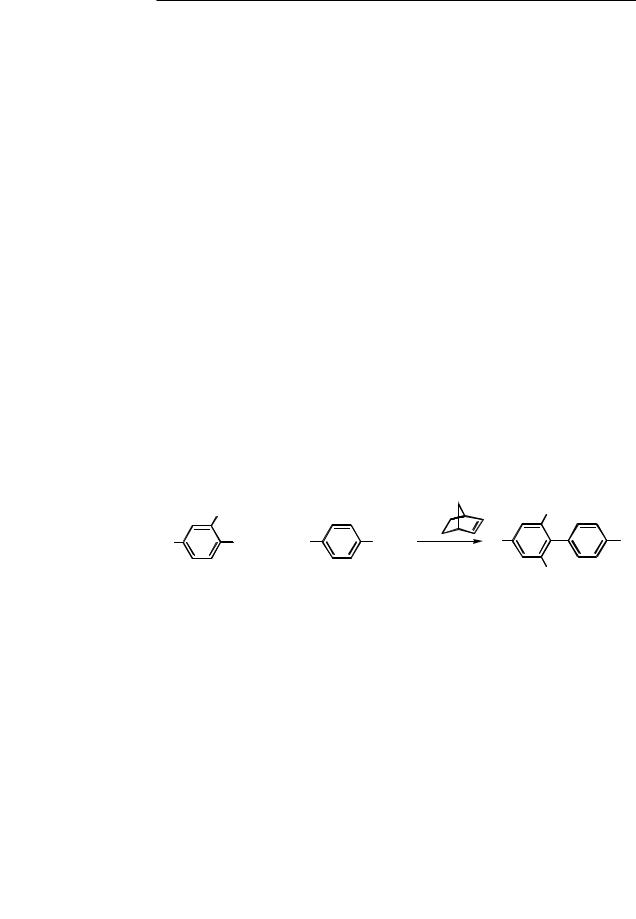
IV.6.2 ARENE SUBSTITUTION INVOLVING TEMPORARY INCORPORATION |
1487 |
TABLE 2. Reaction of o-Substituted Aryl Iodides with Alkyl Iodides and Terminal Alkenes in the Presence of Norbornene, Pd(OAc)2, K2CO3, and KOAc a (see Scheme 16)
|
|
|
Conversion b |
|
|
Ratio (%) |
R1 |
R2 |
Y |
(%) |
1 |
2 |
|
Me |
n-Pr |
CO2Me |
88 |
84 |
16 |
|
Me |
n-Bu |
CO2Me |
72 |
81 |
19 |
|
Et |
n-Pr |
CO2Me |
76 |
93 |
7 |
|
n-Bu |
n-Pr |
CO2Me |
100 |
76 |
24 |
|
n-Bu |
n-Oct |
CO2Me |
62 |
73 |
27 |
|
n-Bu |
i-Pr |
CO2Me |
31 |
25 |
75 |
|
i-Pr |
n-Bu |
CO2Me |
59 |
60 |
40 |
|
t-Bu |
n-Pr |
CO2Me |
20 |
42 |
58 |
|
n-Bu |
n-Pr |
COMec |
43 |
71 |
29 |
|
n-Bu |
n-Pr |
CNc |
47 |
48 |
52 |
|
n-Bu |
n-Pr |
C6H5 |
22 |
46 |
54 |
|
n-Bu |
n-Pr |
4-MeC6H4 |
21 |
50 |
50 |
|
n-Bu |
n-Pr |
4-FC6H4 |
43 |
67 |
23 |
|
aThe reaction was carried out in DMF at 55 °C for 72 h under nitrogen with initial molar ratios of the reagents in the order reported in the title and gradual addition of alkyl iodide and terminal alkene in the amounts shown in parentheses by syringe pump: 1:6(6):1(1): 2:0.2:5:5.
bBased on the aryl iodide by GLC.
cTerminal olefin added by syringe pump (0.2).
As shown in Table 2 the combination of KOAc and K2CO3 turned out to be beneficial in promoting the slower norbornene insertion (Scheme 5) and ring closure (Scheme 9) steps, respectively.
C.iii. Termination by Aryl Derivatives: Symmetrically and Unsymmetrically o,o -Dialkylated Biphenyls
The Pd-catalyzed sequential reaction of the three components aryl iodide, alkyl iodide, and arylboronic acid can be performed in a one-pot operation (Scheme 17 and Table 3).[18]
R1 |
(H) |
|
R1 |
(R3 ) |
|
I + R3 Br + R4 |
|
Pd0, |
|
R2 |
B(OH)2 |
R2 |
R4 |
|
|
|
|
−HI, −HBO2 |
|
|
|
|
R3 |
3 |
Scheme 17
D. ARYLATION: STOICHIOMETRIC SYNTHESIS
OF m-SUBSTITUTED BIARYLS
As pointed out above, the presence of an ortho substituent on the aromatic ring of an arylnorbornylpalladium species leads not only to selective alkylation but also to selective arylation of the aromatic ring. As shown in Scheme 18 and Table 4, biphenyls bearing
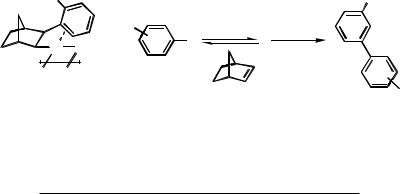
1488 |
IV Pd-CATALYZED REACTIONS INVOLVING CARBOPALLADATION |
|
|||
TABLE 3. Reaction of an Aryl Iodide, an Alkyl Bromide, and an Arylboronic Acid in the |
|||||
Presence of Norbornene, Pd(OAc)2, and K2CO3a |
|
|
|||
|
|
|
|
|
|
|
|
|
|
Yield b (%) |
|
R1 |
R2 |
R3 |
R4 |
3 |
Conversion (%) |
H |
H |
n-Pr |
H |
95 |
98 |
H |
H |
n-Bu |
H |
83 |
86 |
H |
CO2Me |
n-Bu |
H |
89 |
97 |
H |
Me |
n-Bu |
H |
74 |
93 |
H |
H |
n-Bu |
Me |
71 |
77 |
H |
Me |
n-Bu |
Me |
86 |
98 |
H |
H |
n-Bu |
F |
62 |
72 |
Me |
H |
n-Bu |
H |
89 |
96 |
n-Bu |
H |
n-Pr |
H |
70 c |
92 c |
i-Pr |
H |
n-Bu |
H |
82 c |
84 c |
i-Pr |
H |
i-Pr |
H |
71 c |
29 c |
aThe reaction was carried out in DMF at room temperature for 72 h under nitrogen with the molar ratios of the reagents in the order reported in the title: 1:4:1.2:1:0.1:6.
bGC determined yield based on the aryl iodide.
cFor 144 h.
|
R1 |
|
|
R1 |
|
|
|
|
R2 |
1/2 |
|
|
+ |
H2 |
Pd |
X |
I |
||
|
|
−HI, −Pd0 |
||
|
2 |
|
||
|
4 |
|
− |
|
|
|
|
||
|
|
|
|
5 R2
Scheme 18
TABLE 4. Reaction of Complexes 4 with Aromatic Iodides in the Presence of K2CO3a
|
|
Yield b (%) |
R1 |
R2 |
5 |
Me |
4-CO2Me |
61 |
Me |
3-Me |
35, 68 c |
Me |
4-Me |
36, 67 c |
n-Bu |
4-CO2Me |
71, 99 c |
t-Bu |
4-CO2Me |
36 d |
Ph |
4-CO2Me |
76 |
aThe reaction was carried out using compound 4 as a dimer (0.05 mmol),
aryl iodide (0.5 mmol), and K2CO3 (0.3 mmol) in DMF at room temperature for 6 h.
bGC yield based on 4.
cReaction run under reduced pressure (0.1 mm Hg).
dThe main product was compound 2 (R t-Bu, 50% yield).
